December 7, 2007
Air Date: December 7, 2007
FULL SHOW
SEGMENTS
Re-energized on the Hill
/ Jeff YoungView the page for this story
The House approves an energy bill with historic increases in fuel economy standards for cars and trucks. But a provision to increase wind solar and other renewable sources of electricity still faces stiff opposition. Living on Earth's Jeff Young has the latest. (06:00)
Carbon-Sink on the Range?
View the page for this story
TheBuffaloGuys.com is a coalition of ten buffalo ranchers from the American West who claim that raising buffalo for meat is carbon neutral. Host Bruce Gellerman talks with rancher Ken Klemm to find out just how carbon neutral buffalo really are. (06:00)
McCain on Climate Change
/ Steve CurwoodView the page for this story
If he were president, what would John McCain do to combat climate change? Living on Earth host Steve Curwood caught up with Senator McCain on his campaign bus, the Straight Talk Express, in New Hampshire. It’s the third installment of our feature of candidates and their views on one of the most serious global issues. (17:00)
Green Gift Guide
View the page for this story
From recyclable kitchenware to a bike-powered blender….Kara DiCamillo of treehugger.com gives host Bruce Gellerman green gift tips for the holiday season. (04:30)
Cool Fix
View the page for this story
Life in a bubble might be good for climate change. Listener Alan Turner of Wilmington, Delaware uses bubble wrap on windows to keep out the cold. (01:40)
Have a Heart!
/ Bruce GellermanView the page for this story
For 60 years, the residents of Framingham, Massachusetts have been poked and prodded, examined and investigated to help reveal the mysteries of heart disease, the nation's number one cause of death. Host Bruce Gellerman visited Framingham to speak with some of the participants of one of the largest and most important epidemiological studies in history. (11:50)
This week's EarthEar selection
listen /
download
Warbling walruses in cold arctic waters.
Show Credits and Funders
Show Transcript
HOST: Bruce Gellerman
GUESTS: Kara Dicamillo
REPORTERS: Bruce Gellerman, Jeff Young, Steve Curwood
[THEME]
GELLERMAN: From Public Radio International, this is Living on Earth.
[THEME]
GELLERMAN: I’m Bruce Gellerman. Today’s show—saving hearts and winning minds. On the campaign trail, Republican Senator John McCain comes clean about climate change.
MCCAIN: My personal choices are that I ride in one SUV while I see other candidates riding in 12. I haven’t done enough, and I’ve got to do more. And all of us Americans have got to do more. But I can’t stand before you and tell you I’m an example of good behavior as far as climate change is concerned. That wouldn’t be straight talk.
GELLERMAN: And residents of Framingham, Massachusetts have been walking the walk for 60 years—three generations helping to unravel the mysteries of heart disease.
LEVY: I like to tell people, ‘Even if you chose your parents unwisely, there’s still a lot you can do to modify your destiny.’ In other words, it’s in our hands.
GELLERMAN: And very green gifts—for under the ever-green. These stories and more, this week on Living on Earth. Stick around!
[THEME]
ANNOUNCER: Support for Living on Earth comes from the National Science Foundation and Stonyfield Farm.
[THEME]
Re-energized on the Hill
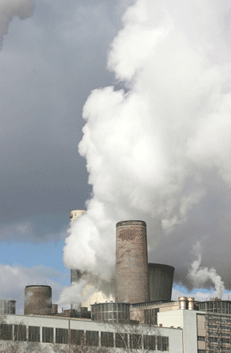
If it becomes law, the energy bill would limit emissions from dirty power plants similar to this one. (Photo: Lawrence Berkeley National Laboratory)
GELLERMAN: From the Jennifer and Ted Stanley Studios in Somerville, Massachusetts, it’s Living on Earth. I’m Bruce Gellerman, in for Steve Curwood.
The U.S. Congress has taken two big steps that could dramatically change the country's approach to clean energy and climate change. In the Senate, a cap on greenhouse gas emissions won an important preliminary vote. And in the House, lawmakers approved an historic energy bill that would make our supply of electricity a lot cleaner and our cars and trucks a lot more fuel-efficient. House Speaker Nancy Pelosi says Congress was highly motivated to pass the energy bill.
PELOSI: The price at the pump is a very compelling reason. It’s as personal to the American people as that, and as global as preserving the planet, and everything in between. It will be a shot heard around the world, for energy independence for our country.
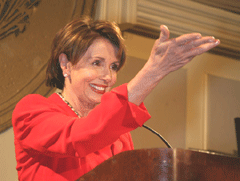
California Democrat Nancy Pelosi, the speaker of the House of Representatives. (Courtesy of Office of the Speaker)
YOUNG: Hey, Bruce.
GELLERMAN: Let’s start with the Senate global warming bill. You’ve been covering this a lot lately.
YOUNG: Well, it’s a pretty big deal. It would be the first mandatory cap on carbon emissions in the U.S. It got out of the environment committee, and it got out of there with no big changes that would weaken it. So this is a bill that would cap those emissions, set up a trading system where companies could buy or sell credits for their CO2 emissions.
GELLERMAN: This was Republican Senator John Warner’s bill, right?
YOUNG: Right. It’s a bipartisan bill. But Senator Warner was the only Republican on the committee to vote for it. Other Republicans are very concerned about the effects this would have on energy prices and the economy. And that’s the issue that’s going to make this bill a real long shot to really make it into law.
In the meantime, however, supporters say just the committee vote alone sent a strong signal to the rest of the world. So, for example, the international leaders gathered right now in Bali to talk about global warming will know, ‘hey, there are people in the United States who are concerned about climate change and who are ready to act.’
GELLERMAN: Well, tell me about the House energy bill. This would what—increase the fuel economy standards. I was reading that the average miles per gallon that a U.S. auto gets is somewhere around 25 miles a gallon, which is actually lower than it was 20 years ago?
YOUNG: Yeah. It’s been three decades since Congress even touched this issue of fuel economy standards. This bill would boost it to 35 miles per gallon by the year 2020. Now there are a few loopholes in there, but this is a very major change. Some environmentalists I’ve talked to say this would be their biggest victory in 20 years—the biggest thing since the improvements to the Clean Air Act.
GELLERMAN: Hmm. Well, give us some context. What does going 35 miles per gallon do, in terms of the oil we use?
YOUNG: It really adds up. This would reduce oil consumption by about a million barrels a day. That’s about half what the U.S. now imports from the Persian Gulf. It would save consumers somewhere around $20 billion, in terms of what they actually pay at the pump. It would also cut CO2 emissions. I read one estimate that says this would be like getting 25 million cars off the road. So it’s a big deal.
GELLERMAN: Wow. I imagine taking cars off the road isn’t going to go over well in Detroit. And plus you have Motor City Congressman big John Dingell. He’s nixed basically every fuel-efficiency standard that’s come down the pike. What’s changed?
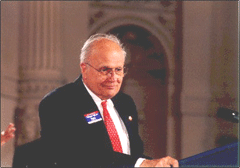
Congressman John Dingell (D-MI) (Courtesy of U.S. House of Representatives)
BECKER: His interest in the environment has always stopped at the car door. The speaker has had a long history of wanting to protect the environment. This became a battle of titans, where the formerly most powerful member of Congress, John Dingell, went up against the new most powerful member of Congress, Nancy Pelosi. And she cleaned his clock.
GELLERMAN: Mmm. Well, tell me about the other provisions in there. What’s this do for renewable energy for electricity?

If it becomes law, the energy bill would limit emissions from dirty power plants similar to this one. (Photo: Lawrence Berkeley National Laboratory)
YOUNG: Well this bill says to utilities: ‘you’ve got to get 15 percent of your power, either through clean sources like wind, solar, geothermal, or biomass, or by improving efficiency in your system.’
GELLERMAN: But I thought a lot of states already had been doing this.
YOUNG: Twenty states already have it. It’s this popular idea called ‘renewable electricity standard.’ But you’ve got some regions of the country—particularly the Southeast—that look at this and they say, ‘you know, most of the clean energy comes from wind, and we don’t have a whole lot of wind. So what we’re going to end up doing here is paying more for our electricity.’ Now I’ve seen some analysis that disputes that, that says they could use solar and whatnot. But this is turning into a big fight, particularly when you consider that the renewables are also tied to a very controversial tax measure in this bill.
GELLERMAN: What’s the tax part?
YOUNG: Right now, oil companies and refineries enjoys a number of tax breaks and basically this bill takes those away and gives that money to renewable energy instead. Now, some Senate Republicans say ‘wait a minute, I thought we had a deal here. We’re going to help you out with the fuel economy standards, but not that tax business, and not that renewable electricity stuff. I caught up with Senator Pete Domenici here in the Capitol not long ago. He’s one of the old bulls of the Senate, the senior Republican on the energy committee, and he is not happy about this.
DOMENICI: They’re saying they’ve got the votes so I don’t know if they’ve got the votes or not. But I do know that if it comes over here we’re going to have—we have no alternative but to have war.
GELLERMAN: Hmm. Those are fighting words, Jeff. Who wins the war?
YOUNG: Well Senator Domenici won the first skirmish. You know you need 60 votes to get anything done in the Senate and this bill got only 53. So they'll try to hammer out a new version. There's also the threat of a veto from the White House. But I think there are 60 votes for the higher fuel economy standards, the other parts look a little shaky. We'll see.
GELLERMAN: Well, thank you very much, Jeff.
YOUNG: You’re welcome.
GELLERMAN: Jeff Young is Living on Earth’s Washington correspondent.
Related links:
- American Council for an Energy Efficient Economy's analyses of the fuel economy standards in the energy bill
- American Council for an Energy Efficient Economy's analyses of the renewable electricity mandate in the energy bill
- The American Petroleum Institute-sponsored study of economic impacts of energy bill
- The Warner-Lieberman Climate Security Act
[MUSIC: Radiohead “A Punchup At A Wedding” from ‘Hail To The Thief’ (Capitol Records—2003)]
Carbon-Sink on the Range?
GELLERMAN: From car standards that save energy to beasts that just might help save the planet. A recent ad in the New York Times caught my eye. 1t was for buffalo meat. ‘Taste positive—carbon neutral,’ said the ad. It seems a group of ranchers that call themselves ‘the buffalo guys’ claim animals that once roamed the Great Plains can cool the climate. They’re raising 3,000 head of bison on ranches in western states, and are shipping steaks and buffalo burgers nationwide. Ken Klemm is one of the Buffalo guys. And Ken, do you really think that buffalo can help fix climate change?
KLEMM: Yes.
GELLERMAN: Convince me.
KLEMM: Well, if you need healthy grasslands to take the carbon out of the atmosphere, buffalo are a key tool in creating and maintaining healthy grasslands to remove the legacy carbon. They do not require a lot of the feeds and care that cattle require because they’re uniquely adapted to the environment. So you don’t have to run a tractor to cut hay, you don’t have to haul the hay off and then haul the hay back to feed them. You don’t need to put them in feedlots and haul the feed to them to get them to market weight. They just need to be fed well right on the range where they’re at. So they’re uniquely adapted to the environment and in so doing they don’t need a lot of chemical-based additives and barns and hay is brought to them and all the many things that cattle would need.
GELLERMAN: Well, take me through this process, because I want to understand how it’s different than say just cows, cattle.
KLEMM: Mmm Hmm. Well, buffalo—first of all, there are billions of acres of land that are dry grazing lands, and buffalo are uniquely adapted to dry grazing lands. Cattle are uniquely adapted to humid grazing lands. Buffalo have sharp hooves for instance, which are designed to actually cut the grass and cut the soil as they walk in the dry lands and help do a little mini roto-tiller action.
Their manure is different. It breaks down much faster in the dry environments. They remain in large herds and stay together and they’re much more powerful so they have greater impact on the land, which is important. You have to stir the land up. A healthy grassland is not a rested grassland. A healthy grassland gets grazed when it needs to be grazed, and rested when it needs to be rested. That’s how you keep a dry grassland healthy. And buffalo are uniquely adapted to that as they coevolved with the grasslands for millennia.
GELLERMAN: So the grass absorbs the carbon dioxide out of the air, the bison churn up the grasslands, eat the grass, sequester the carbon, and then we eat the bison, or the buffalo?
KLEMM: That’s right. They eat the grass. The manure falls to the earth and the microorganisms take that manure, which is just what they’re used to having, and put it in the soil. And the grass is healthy, creates more roots. Puts in—of course the roots is where a lot of carbon is stored, and then we’re actually building soil—a quarter inch, an inch, that adds up.
GELLERMAN: Now don’t buffalo produce methane as an end product?
KLEMM: Well the studies that I’ve read show that methane is only produced in large quantities when the animals are on feedlots. And feedlots, of course, the animals are force fed grain, and it changes their digestive system and makes it, makes them produce a lot of methane. Grazing animals, as near as science can tell, does not, there’s no methane problem.
GELLERMAN: And methane of course is a greenhouse gas.
KLEMM: It is. It’s actually worse than carbon.
GELLERMAN: Now you have buffalo ranches in Kansas and Wyoming, right?
KLEMM: Yes, we do. Kansas and Wyoming and Colorado—and Montana.
GELLERMAN: Now I’m out here in Boston. You must be emitting carbon to transport the meat here to Boston.
KLEMM: Yes, I’m sure we are. Yes, I’m sure we are. Transportation is part of an issue.
GELLERMAN: So it’s not exactly carbon neutral.
KLEMM: Well, I guess we’d have to sit down and do the math, wouldn’t we? But I know that if you take ten million acres and heal the desertified land, that it would remove a gigaton of carbon from the atmosphere. That’s a lot of carbon. And then that would put it in the soil. So, the carbon that’s created in producing the meat—there can be a lot of it that is stored in the soil.
GELLERMAN: You know, I’ve always wanted to ask someone this question: do deer and antelope really play where buffalo roam?
KLEMM: (laughs) Well, the deer don’t play with the antelope, I know that for sure. But they play with each other. And there are—I mean, that’s all part of the ecosystem—the buffalo and the deer and the antelope, and of course before the elk were pushed out of the ecosystem, there was actually a lot of elk there. There were 60 million buffalo as estimated on the American grasslands, which is the greatest mammal mass in the world, even greater than any of the African herds of any specie, and of course right below that would have been the elk, and then there would have been deer and antelope below that.
GELLERMAN: How many buffalo are there in the United States now?
KLEMM: The U.S. and Canada together have about 500,000. We slaughter about 50,000 head a year in the United States and in the United States there’s about 120,000 cattle killed every day. We kill about 50,000 a year. So, by noon on one day of slaughtering cattle, we would be done slaughtering all the buffalo in the United States.
GELLERMAN: Ken Klemm is one of the buffalo guys. It’s been a pleasure talking to you, Mr. Klemm.
KLEMM: Oh, the pleasure’s been mine and I’m grateful that we’ve had this time to talk.
Related links:
- The Buffalo Guys
- To read more about planned grazing, check out Holistic Management International with Allan Savory
[MUSIC: Pete Seeger “Home on the Range” from ‘Cowboy Songs On Folkways’ (Smithsonian Folkways—1991)]
GELLERMAN: Coming up: president wannabe John McCain’s plan for global warming. We hunt the GOP Senator, as he hoofs it through the primary snows of New Hampshire. Stay tuned to Living on Earth.
McCain on Climate Change

(Photo: Jennifer Stevens)
GELLERMAN: It’s Living on Earth. I’m Bruce Gellerman. While scientists warn that climate change threatens our very existence and demands immediate action, it hasn’t been a top issue for Republicans trying to win the GOP presidential nomination. None of the Republican candidates accepted an invitation to speak at last month’s presidential forum on climate change and America’s energy future. But as the primaries get closer, the issue—like the planet—gets hotter.
Living on Earth executive producer Steve Curwood recently caught up with Arizona Senator John McCain in snowy Durham, New Hampshire, where the candidate spoke to a group of workers at Goss International, where they make printing presses. The Senator kicked off with global warming.
[APPLAUSE]
MCCAIN: Thank you. By the way, I’ve been asked by the Phoenix Chamber of Commerce to announce the temperature is 78 degrees in Phoenix today.
[LAUGHTER]
MCCAIN: I just thought I’d—but we have no water in Arizona. You may know California’s stolen all of Arizona’s water. In fact, we have so little water in Arizona the trees chase the dogs—
[LAUGHTER]
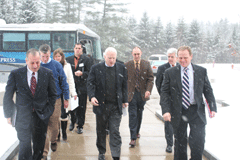
Senator John McCain and his staff brave the snow to campaign in New Hampshire. (Photo: Jennifer Stevens)
And I went back to the Senate and I got involved in the issue and we had hearings and my friends I just want to say to you unequivocally I believe that it’s real. I believe there’s enough evidence out there to convince us at least to try to take action to reduce greenhouse gas emissions and maybe I could put it to you this way: suppose we are wrong, those of us that believe that the large body of scientific evidence indicates that climate change is taking place, suppose that we adopt green technologies and we are wrong. Well all we’ve done is given our kids a cleaner planet with less greenhouse gas emissions. But suppose we are right. Suppose we are right and that there is serious damage being done or can be done to our planet by so called ‘greenhouse gases’ then I think and do nothing. Then I think obviously we would not be proud of what we’re handing on to future generations of Americans. And I’ve traveled all over the world, usually at your expense, and I’ve been to the Arctic, I’ve been to the South Pole, I’ve been to Greenland, I’ve been to other places where I’ve seen manifestations of this. And scientists are notoriously cautious, but most scientists now agree that at least to some degree that it’s taking place.
Now what do we need to do? We don’t have to shiver in the dark. We don’t have to make drastic changes in our lifestyle. But one of the things I think we need to do is expand and reemphasize the need for nuclear power. I believe that nuclear power works. I believe that it is viable. I see an Old Navy man over there who will tell you that for more than 60 years, the United States Navy has sailed ships around the world with nuclear power plants on them. By the way, our friends the French—80 percent of their electricity is generated by nuclear power. We all want to imitate the French, as you know. But the fact is—and by the way the French now have a pro-American president, which shows that if you live long enough, anything can happen in this world—
[LAUGHTER]
MCCAIN: -- as I know you know. So, the question with nuclear power, my friends, is what do you do with the waste? And the fact is we’ve got the worst of all worlds now because we haven’t been able to do anything with it so we’ve got these nuclear waste places all over America—outside the nuclear power plants. So, we need to sit down as a nation and fix it. And I’m for finding a Yucca Mountain or any place else we want but the technology is there, the licensing process should be accelerated, and nuclear power has got to be part of it. Otherwise, we will be building utilities that are emitting greenhouse gases and obviously that’s not something we want for our kids.
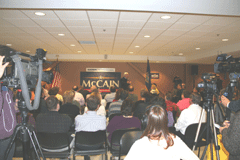
John McCain at a town hall meeting in New Hampshire. (Photo: Jennifer Stevens)
And finally let me remind you—there is a need to reduce our dependence on foreign oil, which joins up with this need to reduce greenhouse gas emissions in my view. A lot of times at town hall meetings I bring a picture of the president of Iran embracing the president of Venezuela. Another picture of President—I use the term loosely—Putin of Russia. Those three people have their hands on a lot of the world’s oil supplies. Not to mention the Iranians, the Nigerians, etcetera. And so there is an absolute requirement for us to reduce our dependency on foreign oil and I think we can do that with our effort to reduce greenhouse gas emissions.
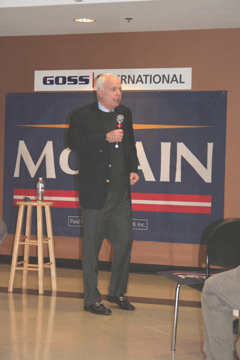
Senator John McCain (R-AZ) speaks to a group of manufacturers at Goss International in New Hampshire. (Photo: Jennifer Stevens)
MCCAIN: On the issue of the last election and the upcoming election: in 2006, Republicans lost the last election and they lost big time here in the state of New Hampshire. I know you know that. Why did Republicans lose so badly? It wasn’t because of the war on Iraq. It was because we Republicans let spending get completely out of control. We came to power in government in 1994 to change government and government changed us. We began a spending spree that resulted in the biggest increase in the size of government since the Great Society. Republicans. Republicans. Conservative Republicans! And our base got alienated and angry, and I don’t blame them. I don’t blame them at all. We spent $3 million of your tax dollars to study the DNA of bears in Montana. I don’t know if that was a paternity issue or a criminal issue.
[LAUGHTER]
MCCAIN: But it was your tax dollars. The turning point—the turning point my friends, of course as many of you know the tipping point was when the $233 million bridge in Alaska to an island with 50 people on it. Next time you’re stuck in traffic think about what we could do with that money. And it led to corruption. I don’t use the word lightly. We now have former members of Congress residing in federal prison. I just want to promise you as president of the United States, I have an old veto pen—this isn’t it—that Ronald Regan gave me years ago—and I’ll veto every pork barrel bill that comes across my desk. I’ll make them famous, and I will stop it. We’ve got to stop these wasteful and outrageous spending practices in Washington.
[APPLAUSE]
[SOUND OF BUS DRIVING AND HONKING]
CURWOOD: After Durham, Senator McCain set off to Dover, New Hampshire in his bus—the Straight Talk Express. I climbed aboard for some straight talking on climate change.
[SOUND OF TALKING INSIDE BUS]
CURWOOD: Please, sit down for a moment. When you talked about climate change in front of the audience today—not a whole lot of reaction. So how do you get a mandate from the public to do the kinds of things that you want to do on climate change?
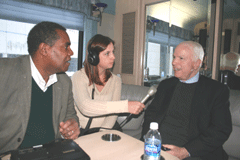
John McCain takes questions from Steve Curwood in the back of the Straight Talk Express. The audio engineer is Bobby Bascomb. (Photo: Jennifer Stevens)
CURWOOD: Let’s be blunt. It doesn’t seem like there are a lot of votes for you when you speak out about climate change.
MCCAIN: It doesn’t matter. (laughs) You know, it’s my obligation. I mean, you’ve got to do what you think is right and keep talking about it. I mean, it’s such a threat to our planet and our future and our children. It’s just an obligation you have.

LOE Host Steve Curwood and the Straight Talk Express in New Hampshire. (Photo: Jennifer Stevens)
[IN QUIET ROOM]
CURWOOD: So right now in the U.S. we don’t reprocess nuclear fuel and that means that of say 100 percent of energy that’s in uranium we only take 5 percent out before we call it waste—95 percent of the power is still in it. People have objected to reprocessing because it goes through plutonium and there are security issues with that. How do you feel about reprocessing? If you go do a major nuclear plant as France has or Japan, they do a lot of reprocessing. Would we do that here?
MCCAIN: I’d have the scientific debate but I probably would have the first option and that is to have a place to store it and store it safely. But I’m willing to look at any option that we can sell to the American people. I’m not against anything. I think that storage—because Yucca Mountain is there—and I’ve always believed it could be safely stored there should the option first.
CURWOOD: Typically, members of your party, the Republican Party, have been reluctant to address climate change. Why are you different?
MCCAIN: I think because of my travels, my experience, my studies. As chairman of the commerce committee for six years we had numerous hearings and I’ll tell you, they were not well attended. But I’ve become convinced of it.
CURWOOD: Now, the last three presidents of the United States have made a gesture in office saying that they would deal with global warming. George Bush the elder signed the original framework convention on climate change. President Clinton signed the Kyoto Accord. George Bush in his campaign said that CO2 was a pollutant—changed his mind later. So, what past three presidents have failed really to deal effectively with climate change. How and why would you make a difference?
MCCAIN: Well I know the issue. I’ve studied it. I’ve worked on a bipartisan basis—Joe Lieberman and I have proposed a quote ‘cap and trade,’ which is being employed in Europe, which has been stumbling by the way but still the principal is right. We did the same thing with acid rain. But I think the other factor that will give dramatic impetus to this issue—it’s now tied in my view and I think I can tie it in the minds of the American people—with a need for energy independence.
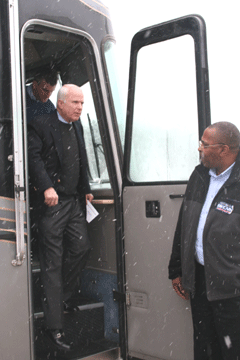
Senator McCain and his campaign vehicle, the Straight Talk Express, in snowy New Hampshire.(Photo: Jennifer Stevens)
CURWOOD: So, how do we restore our credibility on foreign policy in the area of global warming? We signed Kyoto but we pulled out. The rest of the world points to us and says that we’re the last country standing. In fact Australia has now moved forward to ratify Kyoto, so we’re the last industrialized nation that hasn’t gone forward with an international agreement. How do we restore our credibility?
MCCAIN: I’d push hard for an international agreement, but you forgot to mention that India and China aren’t part of it. And India and China must be part of any global effort. The two largest emerging economies have to be a part of it.
CURWOOD: We’ve got a bit of a standoff problem with India and China because in the earlier negotiations the U.S. agreed to go first. So they’re looking at us saying ‘What about you guys?’ and we’re looking at them because of course, the growth in emissions from China and India is going to be quite large in the years ahead. How do you break this impasse? It’s a stalemate, really.
MCCAIN: Uh, look, if India and China want to join they can join. We’ll join together. I mean, that’s a straw man that they’re setting up and the Chinese are very worried about their enormous contributions to pollution. It’s already affecting Los Angeles, so let’s be very clear with China first and also India. Look, it doesn’t matter who goes first. We should all go together. It’s baloney.
CURWOOD: Okay. Let’s fast forward and John McCain is now being sworn in as president of the United States. And if that happens what do you do in your first 100 days to address global warming?
MCCAIN: I think we try to get a cap and trade system through the Congress. I think we use the bully pulpit to explain to the American people about the conjunction of two serious issues—the need for energy independence, and the need—our dependence on foreign oil—and also the need to address the issue of climate change. I would make it a top agenda. I would begin negotiating with other countries. I would join Kyoto or a worldwide agreement, but only if India and China were a part of that agreement. You’ve got to convince them as well. So, and I would devote more effort probably on the governments part to pure R and D and I emphasize pure R and D. The free enterprise system does these things a lot better once you get out of the pure R and D phase. And I’d unleash the millions of Americans—young Americans today, who view this as a threat and challenge to their lives.
CURWOOD: Now, science tells us that already a billion people around the world are going to face the adverse effects of climate change, and most of them are pretty poor. And the changes for these folks is inevitable. We’re seeing the equivalent of Katrina right now in Bangladesh, for example. How would you deal with addressing those folks around the world—the poor around the world who are being impacted by climate change already?
MCCAIN: You know one of the areas that they’re first being addressed are in native Alaskan villages up on the Arctic Circle and in other parts where they’re next to the water, where they’re seeing their villages literally collapse into the ocean. And we’re going to have to go through relocation there. You know, there’s not a lot you can do as far as preventing for example, Bangladesh from having higher and higher sea level because of the progress of this climate change and melting of the polar ice caps. But I would definitely provide disaster relief, etcetera, etcetera. But I would also point out the graphic demonstration. There are island nations in the Pacific, we are told, that may literally disappear or lose a vast majority of their landmass because of this increase in tides and the other thing is that with the violent weather patterns will increase. I think most experts, and I believe, on climate change will tell you it’s not only a case of warming, but it’s also a case of much more violent weather patterns that are going to—and then of course that increases the disasters that befall countries like Bangladesh.
CURWOOD: Senator, before you go, tell me—what personal choices have you made in response to your concern about climate change?
MCCAIN: Oh, we have solar panels up north in our place in Arizona. My daughter drives—has bought a hybrid. But we haven’t done enough. We haven’t done enough. My personal choices are that I ride in one SUV while I see other candidates riding in twelve. (laughs). But the fact is that I haven’t done enough and I’ve got to do more. And all of us Americans have to do more. But I can’t stand before you and tell you I’m an example of good behavior as far as climate change is concerned. That wouldn’t’ be straight talk.
CURWOOD: I want to thank you for taking this time. Arizona Republican Senator John McCain. Thank you, sir.
MCCAIN: Thank you very much. Thanks. I’m sorry we’ve got to run.
GELLERMAN: LOE’s Steve Curwood with Senator John McCain—running in New Hampshire. For more of our coverage of the Presidential candidates’ positions on climate change, check out our website: loe.org. Next in our series of candidates and global warming—Representative Dennis Kucinich.
Related links:
- Senator John McCain's 2008 Campaign Site
- Senator John McCain's Senate site
[MUSIC: Miles Davis “Minnie” from ‘The Complete On The Corner Sessions’ (Columbia Legacy—2007)]
GELLERMAN: You can hear our program anytime on our website, or get a download for your MP3 player. The address is loe.org. That's L-O-E-dot-O-R-G. You can reach us at comments @loe. Org. Once again, comments @L-O-E-dot-O-R-G. Our postal address is 20 Holland Street, Somerville, Massachusetts, 02144. And you can call our listener line, at 800-218-9988. That's 800-218-99-88.
Just ahead, all I want for Christmas is—a bicycle-powered blender? And Framingham, Massachusetts—the heartbeat of America for 60 years. Keep listening to Living on Earth.
ANNOUNCER: Support for the environmental health desk at Living on Earth comes from the Cedar Tree Foundation. Support also comes from the Richard and Rhoda Goldman Fund for coverage of population and the environment.
This is Living on Earth on PRI: Public Radio International.
Green Gift Guide
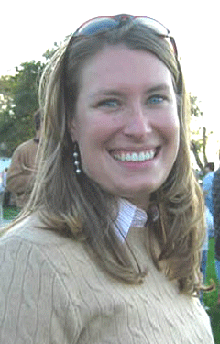
Kara DiCamillo compiled treehugger.com’s Green Gift Guide. (Courtesy of Kara DiCamillo)
GELLERMAN: It’s Living on Earth, I’m Bruce Gellerman. Well, for the past few years green has been the new white for Christmas, as manufacturers try to appeal to a growing number of consumers looking for eco-friendly gifts.
This year we're making a green shopping list and checking in twice with Kara Dicamillo. She's a senior writer for TreeHugger.com and the editor of their green gift guide. This is actually the second year we're talking with Kara about gifts that keep giving. Welcome back, Kara.
DICAMILLO: Thank you, Bruce!
GELLERMAN: So, I haven’t been too naughty this year. What can Santa, or in my case Santastein, bring me this year?
DICAMILLO: Well, we have over 180 gift ideas and 12 different categories, so there’s actually a lot that Santa can bring you this year.
GELLERMAN: Well, I like things electronic.
DICAMILLO: Well, we have a solar laptop charger. It actually provides almost an entire day’s work from the sun, and we also have an h-racer fuel cell car, it runs on hydrogen and you can fuel up from the sun because they have a solar-powered fueling station.

Kara DiCamillo compiled treehugger.com’s Green Gift Guide. (Courtesy of Kara DiCamillo)
DICAMILLO: Yes, it is.
GELLERMAN: Too bad. What about in the non-electronic category?
DICAMILLO: We actually have some great gifts this year for people who enjoy the kitchen. There’s a company called Recycline and this year they’re making colanders and storage containers and cutting boards out of recycled plastic. And what’s great about their stuff as well is that when you’re finished with the cutting board—hopefully it won’t be anytime soon—you can throw it into the recycle bin because it’s a number five.
GELLERMAN: What else Kara? Something for the home, perhaps?
DICAMILLO: Something that I think everybody can use is something called a power-cost monitor. It allows you to monitor your home’s energy use and it tells you what it’s costing you and actually which appliances are sucking up the most energy in your home.
GELLERMAN: And I get it daily, hourly, or minute-by-minute?
DICAMILLO: It’s minute-by-minute actually.
GELLERMAN: Wow, I’d be looking at that thing all day long. I mean, as it is I’m kind of like the light monitor in my house.
DICAMILLO: (laughs)
GELLERMAN: What about this electric bike kit you’ve got?
DICAMILLO: Well that kit is very cool. It’s under our DIY category, which means do it yourself. And what it does is you can transfer your bike into an electric one.
GELLERMAN: So you’ve got an electric bike kit and you’ve also got a blender that’s powered by a bike.
DICAMILLO: Yes, we do. Yes, we do. You hook it onto the back of a bike and start peddling away and voila, you have margaritas.
GELLERMAN: (laughs) So, a lot of stuff, a lot of people are saying ‘enough is enough,’ with stuff. What options do they have for gift giving?
DICAMILLO: Well, one of the best things you can give is gift certificates, whether it be to local restaurants, or local eco spas. I think the best thing is to shop local and stay local. There’s a lot of carbon emissions that gets burned from when you order things from outside of your local area.
GELLERMAN: Well, at least with some of those gifts you don’t have to gift wrap, but a lot of the things you buy of course you do have to wrap. Any ideas about, or tips about wrapping and taping up all those presents?
DICAMILLO: Well wrapping paper is actually one of the biggest wasters during the holidays and just to put a number on it, just between Thanksgiving and Christmas, on average consumers increase their garbage by about 25 percent. That’s a pretty big number for just a couple of weeks. So, when it comes to wrapping paper, we recommend to maybe re-use old maps, to reuse newspaper. And if you are going to buy gift wrap, make sure you buy some that is recycled. But they do have wrapping paper out there that’s made of hemp and flax. And while you’re at it, there’s a new tape out there called ‘Sellotape’ and it’s actually made from biodegradable plant cellulose.
GELLERMAN: I’d like to put some tape on my wallet.
DICAMILLO: (laughs)
GELLERMAN: Before I let you go, Kara, what’s on your wish list this year?
DICAMILLO: Let’s see, I do like the Strida 5 folding bike. And what it is, is it’s a bike that you can fold up and it’s small enough to carry on the train or the bus. So it’s perfect for people that live in the city like me.
GELLERMAN: Kara, may all your Christmases be green.
DICAMILLO: Thank you. You too.
GELLERMAN: Kara DiCamillo is a senior writer for TreeHugger.com and the editor of their green gift guide. If Santa wants more info—there’s a link to TreeHugger.com at our website: loe.org.
Related links:
- TreeHugger.com's 2007 Green Gift Guide
- How to green your gifts
- Grist's ten "stuff-free" gift ideas
- The World Wildlife Fund's Extraordinary Gifts
[MUSIC: Ray Charles & Betty Carter “Baby It’s Cold Outside” from ‘Ray Charles And Betty Carter’ (Dunhill Records—1988)]
Cool Fix
GELLERMAN: Brrr. It’s cold out there. It’s winter and one of the biggest places you lose heat in a home is through your windows. A third of that expensive warmth goes out the window—through the panes and cracks. So don’t forget to putty up those leaks! And as for the glass—it can be a real pain in the wallet.
Listener Alan Turner of Wilmington, Delaware has a trick he learned in horticulture school to keep the heat in, and fight climate change. Here’s Alan’s “Cool Fix for a Hot Planet.”
[COOL FIX THEME]
TURNER: In the greenhouses we used to take bubble wrap and we’d get the glass wet and then we’d stick the bubble wrap to the glass, flat side down and the moisture just makes it stick. If you have single pane windows or even with storm windows, just take a spray bottle and spritz the glass with water, stick the bubble wrap up, flat side to the glass, and it sticks there and makes a huge difference in the heat. And it still lets the light in and it’s cheap. And it has all those little tiny insulating cells that do a good job. And stay warm!
GELLERMAN: And you thought bubble wrap was only good for—
[SOUND OF BUBBLE WRAP POPPING]
GELLERMAN: And for your cool fix, Alan, we're going to send you a Living on Earth tire gauge. Use it to keep your tires correctly inflated and it could save you as much as $432 a year. That's according to a study from Carnegie Mellon University.
And if you have a Cool Fix for a Hot Planet, let us know. If we use your idea on the air, you too will get an LOE tire gauge. Call our listener line at 800-218-99-88. That's 800-218-9988. Or email coolfix—all one word—at loe.org. That's coolfix@loe.org.
[MUSIC: Benny Goodman “We’ll Meet Again” from ‘Sentimental Journey: Hits From The Second World War’ (Legacy—2007)]
Have a Heart!
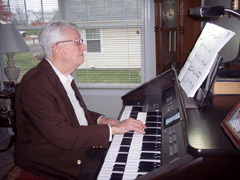
93-year old Walter Sullivan has been a heart study participant from the beginning. (Photo: Bruce Gellerman)
GELLERMAN: In 1945 more Americans died of heart disease than all the U.S. soldiers killed in action in World War II. Cardiovascular disease has been an epidemic since 1921, when it became the leading cause of death in the United States. Cardiologist Dr. Daniel Levy:
LEVY: Remarkably very little was known about its underlying causes. Even less known about its treatment, and absolutely nothing was known about approaches to its prevention. Really, the wake-up call was when President Roosevelt died in 1945 from untreated, uncontrolled hypertension.
OLD NEWS BROADCAST: We interrupt this program to bring you a special news bulletin from CBS World News. A press association has just announced that President Roosevelt is dead. The president died of a cerebral hemorrhage. All we know so far is that the president died at Warm Springs in Georgia.
LEVY: Shortly before he died, when he was in Yalta in February of 1945 carving up the map of the free world, his blood pressure was running about 250 over 150—numbers that many physicians in training today never see.
GELLERMAN: That’s because today physicians know a lot more about the causes and prevention of cardiovascular disease, thanks in large measure to the small town of Framingham, Massachusetts, 20 miles west of Boston. Residents of Framingham had participated in a study of tuberculosis during World War I. So in 1948, when federally funded Harvard university researchers went looking for a convenient place to study heart disease, they chose Framingham. Five thousand two hundred and nine adults volunteered to undergo medical exams every other year. Now the Framingham Heart Study is commemorating its 60th anniversary. It’s one of the largest, longest-running, and most important observational medical studies in the world.
Dr. Daniel Levy is director of the study and author of the book, “A Change of Heart: How the people of Framingham, Massachusetts helped unravel the mysteries of heart disease.”
LEVY: One of the reasons Framingham was so good for this study was because it was so ordinary. There was nothing exceptional about it. It was average people, a little cross section of America, albeit of white America. But Framingham was not an unusual town. We very much lucked out. Society has lucked out that there’s a community that’s willing to get poked and prodded have blood taken from you and get nothing in return financial whatsoever.
[SOUND OF DRILLING]
GELLERMAN: Framingham dentist David Anghinetti is one of those who study researchers have poked and prodded.
ANGHINETTI: We put on those silly gowns and they do soup to nuts.

Dr. Anghinetti (Photo: Bruce Gellerman)
ANGHINETTI: Both of my parents were original participants. My mother had just some mild hypertension but she lived to 98 and a half. My father will be 102 and he doesn’t have any heart disease. When they got the additional funding to carry on the study, they then wanted to get the children involved and as soon as I got notified, I became a participant. My son has gone. My daughter has not been called but hasn’t gone yet. And I’m hoping that my daughter will take advantage of it. And, you talk to any participant, they’ll all tell you the same story: the relationship that—and a bond and a trust and an admiration that the participants have for the researchers and the researchers have for the participants.
[CYCLING SOUNDS]
SULLIVAN: They like you to have you get your heart rate up to—maybe in my case—maybe a hundred.
GELLERMAN: Walter Sullivan is also a participant. He hops on the stationary bicycle he keeps parked in the bathroom of his home at a senior community in Framingham.

The Framingham heart study findings have spurred Walter Sullivan to keep up the healthy exercise.(Photo: Bruce Gellerman)
GELLERMAN: At 93, Walter Sullivan is one of the younger surviving members of the original study. About 400 are still alive. Sullivan practiced law until a few years ago. In 1993, he had a heart attack. And later, a bout of cancer. But these days he’s feeling fine, except for a new hearing aid which he doesn’t like much, especially when he’s chewing lettuce.
SULLIVAN: So if I have a salad it goes crunch, crunch, crunch. So I take the damn things off.
GELLERMAN: Walter Sullivan’s wife Katy was also an original heart study participant. She was 87 when she died in 1999, a victim of the silent killer that strikes half a million Americans a year.
SULLIVAN: She had a stroke so she never recovered consciousness and she died the next morning. She had no history of that.
GELLERMAN: The Framingham researchers only collect data. If they find something medically wrong with a volunteer they don’t treat them, but send the test results to their personal physicians. When the study began in 1948 few people had health insurance so volunteering was one way to get regular medical exams.
SULLIVAN: This will be my 30th next year, every two years for 60 years. I look forward to it.
GELLERMAN: Your participation in this study, it seems to me may have contributed to extending the lives of countless numbers of people.

93 year-old Walter Sullivan has been a heart study participant from the beginning. (Photo: Bruce Gellerman)
GELLERMAN: Walter Sullivan’s three children and now seven of his grandchildren also participate in the heart study. Again, director Daniel Levy:
LEVY: When we recruited our third generation of participants, literally there was hardly a day went by when one of these 3rd generation individuals did not come in and say, ‘I have waited all my life for this day to come.’ And every time I heard that it gave me goose bumps.
GELLERMAN: Dr. Levy calls the study’s database a national resource. Among the most significant findings—that smoking, menopause, high cholesterol, and high blood pressure increase your risk of heart disease. Now, this may seem obvious today, but identifying the risks has helped cut the rate of cardio-vascular diseases by 60 to 70 percent. Yet despite this, heart disease is still the number one cause of death in America.
The Framingham Heart Study has produced over 15 hundred articles in leading medical journals, and it’s mission has again been expanded. Researchers are now mining their data to discover the genetic basis of not just heart disease and stroke, but cancer, arthritis, diabetes and dementia. It could lead to new ways to diagnose and treat these illnesses. But Dr. Levy is cautious about emphasizing the genetic links to disease:
LEVY: I like to tell people; ‘even if you chose your parents unwisely, there’s still a lot you can do to modify your destiny.’ In other words it’s in our hands. Yes, having family members with premature disease can roughly double your risk of heart attack compared to someone with no family history but much of that is mediated through things we can control. So even if you do have a bad family history, by keeping your cholesterol level low, your blood pressure low, by not smoking, by being physically active, we would eradicate about 90 or 95 percent of heart disease.
[STUDY PARTICIPANT WALTER SULLIVAN PLAYS “STARDUST” ON ORGAN]
GELLERMAN: Ninety three-year old heart study volunteer Walter Sullivan follows the life sustaining advice, and then some. A few years ago he answered a newspaper ad placed by a local music company.
SULLIVAN: They formed a group of older people. And they offered to give them lessons for the rest of their lives if they bought an organ (laughs).
GELLERMAN: You’re getting your money’s worth, aren’t you?
SULLIVAN: But my life must have ended two or three years ago because they stopped the lessons, mostly because the participants moved away or died. So I just do it on my own now.
GELLERMAN: Walter Sullivan turns 94 on February 19th. And the Framingham Heart Study enters its 7th decade. Both—still going strong.
[“STARDUST” FINISHES]
SULLIVAN: Not very good, is it?
GELLERMAN: It’s great.
SULLIVAN: But I have fun.
[MUSIC: Clifford Brown “Stardust” from ‘Brownie: The Complete Emarcy Recordings Of Clifford Brown’ (Emarcy Records—1989)]
GELLERMAN: On the next Living on Earth, we go to Bali, and the UN Conference on Climate Change. It’s billed as the last best chance to come up with a plan to save the planet. Ten thousand delegates from 190 countries are in Bali devising a framework to go forward after Kyoto. The fight over global warming heats up—next time on Living on Earth.
Related links:
- The Framingham Heart Study
- The National Heart Lung and Blood Institute's site dedicated to the Framingham Heart Study
[SOUND OF WATER SPLASHING, ANIMAL NOISES]
GELLERMAN: We leave you this week down under. Down under water, that is. Researcher Les Gilbert recorded this group of walruses off the coast of Alaska. Walruses have air sacs under their throats, which allow them to float in the water as they sleep, and let them produce these underwater sounds.
[MUSIC: Les Gilbert “Round Island, Alaska: Underwater Walrus” from ‘Why Do Whales And Children Sing’ (Earth Ear—1999)]
GELLERMAN: Living on Earth is produced by the World Media Foundation. Our crew includes Ashley Ahearn, Bobby Bascomb, Eileen Bolinsky, Ingrid Lobet, Helen Palmer, Emily Taylor, and Jeff Young. Our interns are Alexandra Gutierrez and Mitra Taj.
Jeff Turton is our technical director. Alison Lirish Dean composed our themes. Steve Curwood is our executive producer. He joins us next week from Bali. You can find us at loe.org. I’m Bruce Gellerman. Thanks for listening.
ANNOUNCER: Funding for Living on Earth comes from the National Science Foundation, supporting coverage of emerging science. And Stonyfield Farm: organic yogurt and smoothies. Stonyfield pays its farmers not to use artificial growth hormones on their cows. Details at Stonyfield.com. Support also comes from you our listeners, the Ford Foundation, the Town Creek Foundation, the Oak Foundation, supporting coverage of climate change and marine issues, and Pax World Mutual Funds, socially and environmentally sustainable investing. Pax World: for tomorrow. On the Web at PaxWorld.com.
ANNOUNCER 2: PRI: Public Radio International.
Living on Earth wants to hear from you!
Living on Earth
62 Calef Highway, Suite 212
Lee, NH 03861
Telephone: 617-287-4121
E-mail: comments@loe.org
Newsletter [Click here]
Donate to Living on Earth!
Living on Earth is an independent media program and relies entirely on contributions from listeners and institutions supporting public service. Please donate now to preserve an independent environmental voice.
NewsletterLiving on Earth offers a weekly delivery of the show's rundown to your mailbox. Sign up for our newsletter today!
 Sailors For The Sea: Be the change you want to sea.
Sailors For The Sea: Be the change you want to sea.
 The Grantham Foundation for the Protection of the Environment: Committed to protecting and improving the health of the global environment.
The Grantham Foundation for the Protection of the Environment: Committed to protecting and improving the health of the global environment.
 Contribute to Living on Earth and receive, as our gift to you, an archival print of one of Mark Seth Lender's extraordinary wildlife photographs. Follow the link to see Mark's current collection of photographs.
Contribute to Living on Earth and receive, as our gift to you, an archival print of one of Mark Seth Lender's extraordinary wildlife photographs. Follow the link to see Mark's current collection of photographs.
 Buy a signed copy of Mark Seth Lender's book Smeagull the Seagull & support Living on Earth
Buy a signed copy of Mark Seth Lender's book Smeagull the Seagull & support Living on Earth

